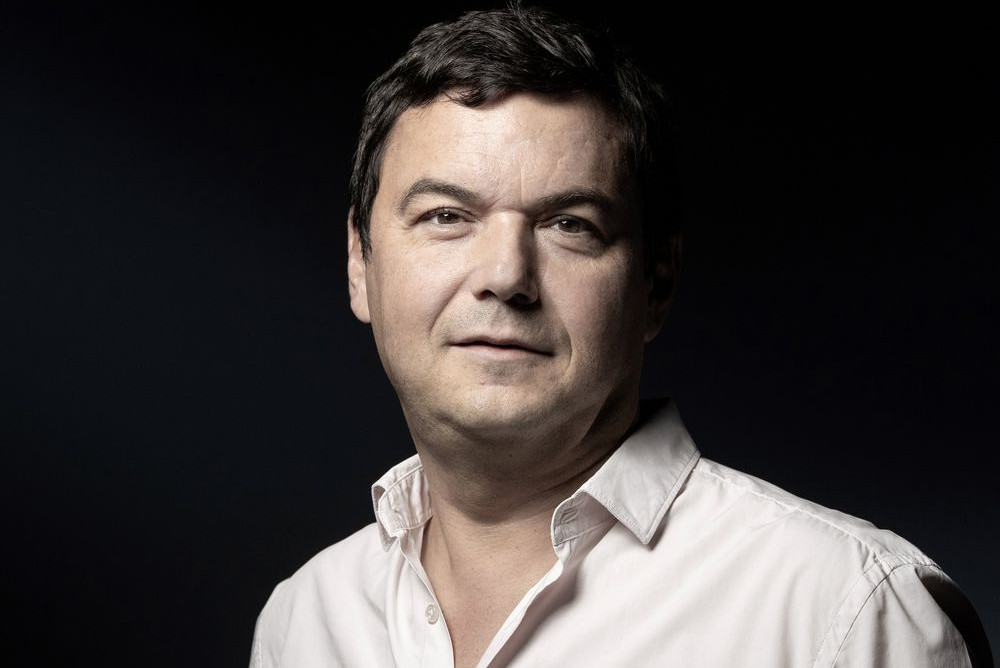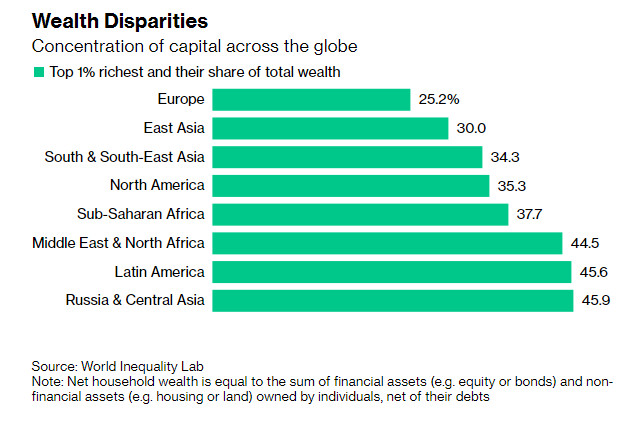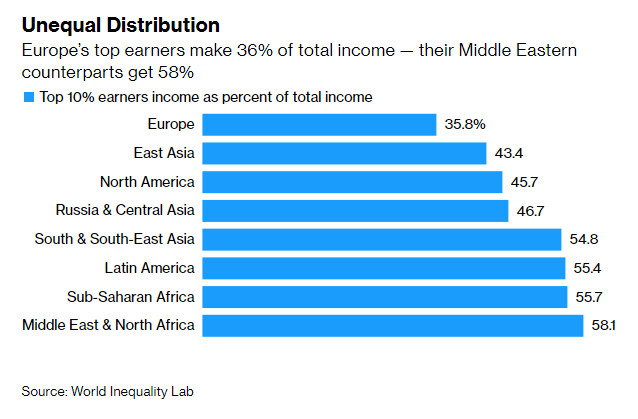
Date: 2025-04-03 Page is: DBtxt003.php txt00021350
Economy
Inequality
Economics ... Billionaires’ Wealth Surged to Record During Pandemic, Piketty Lab Says

Thomas Piketty Photographer: Joel Saget/AFP/Getty Images
Original article: https://www.bloomberg.com/news/articles/2021-12-07/pandemic-is-golden-age-for-billionaire-wealth-piketty-lab-says
Burgess COMMENTARY
The problem of growing inequality has been ignored by those with wealth and power for all my adult life. There does not seem to be much of an appetite to address the problem. The growth of inequality in the last two decades has accelerated, enabled significantly by the underlying economics of digital technology.
I am most upset, not so much by the extraordinary amount of wealth accumulation that is attributed to a rather few wealthy individuals, but by the emormous number of people on planet earth that are destitute, undernourished and insecure, and will die prematurely. This is a systemic failure that does not seem to get anything like the attention it deserves ... not in academia, not in corporate boardrooms and investment meetings, not in innternational organizations, not in the media, not among politicians ,,, essentially nowhere!
I got this article from the Bloomberg organization ... a source of a lot of good and interesting news ... but also an organization that seems to be far better at addressing the possibilities of wealth accumulation than wider access to quality of life. Michael Bloomberg is associated with some important philanthropic activities, but they seem trivial by comparison with the power and influence of his media powerhouse. Maybe I am misinformed ... it would be nice ... but I am fearful that the world is on a very slippery slope to much more poverty and deprivation while the rich world looks the other way.
Peter Burgess
Bloomberg New Economy
Bloomberg
Hello. Today we look at how the rich got even richer during the pandemic, the easing of monetary policy in China, and which governments managed to save money during the crisis.
A Golden Age for Billionaires
It’s been almost a decade since Thomas Piketty delivered 900 or so pages on “Capital in the 21st Century,” a tome which went on to sell more than 2.5 million copies in 40 languages.
Now a group he founded is back in the headlines with an estimate that the Covid-19 crisis served as a fuel for the bank balances of the global elite.
About 2,750 billionaires now control 3.5% of the world’s wealth, according to the Paris-based Global Inequality Lab.
That’s up from 1% in 1995 and the fastest gains came after the pandemic hit.
As a point of reference, the poorest half of the planet’s population owns about 2% of its riches.
Such findings add to a debate about worsening inequality during a public health crisis that’s hurt developing economies — which are short of vaccines as well as financial resources to cushion the blow — even more than advanced ones.
Within the rich world too, financial and real-estate markets have soared since the depths of the slump last year, widening domestic gaps.
Interestingly, wealth gaps are reflected in bigger carbon footprints, too. In North America, for example, the top 10% emits an average 73 metric tons per capita each year, compared with less than 10 tons for the poorest half.
Read more here / below.
-----------------------------------------------------------
Economics ... Billionaires’ Wealth Surged to Record During Pandemic, Piketty Lab Says
By Augusta Saraiva and Alessandra Migliaccio ... — With assistance by Giovanni Salzano
December 7, 2021, 2:30 AM EST
New report shows record-high share is held by the richest ... Europe has smallest disparities, says Global Inequality Lab
The share of global wealth held by billionaires surged to a record during the Covid-19 crisis, according to a group founded by French economist Thomas Piketty.
About 2,750 billionaires control 3.5% of the world’s wealth, the Paris-based Global Inequality Lab said in a report Tuesday. That’s up from 1% in 1995, with the fastest gains coming since the pandemic hit, the group said. The poorest half of the planet’s population owns about 2% of its riches.
The study’s findings add to a debate about worsening inequality during a public health crisis that’s hurt developing economies -- which are short of vaccines as well as financial resources to cushion the blow -- even more than advanced ones. Within the rich world too, financial and real-estate markets have soared since the depths of the slump last year, widening domestic gaps.
Wealth Disparities
Concentration of capital across the globe

Note: Net household wealth is equal to the sum of financial assets (e.g. equity or bonds) and non-financial assets (e.g. housing or land) owned by individuals, net of their debts
Those pandemic trends come after decades of policy that was often geared toward people at the top, on the expectation that it would “trickle down” and everyone else would ultimately benefit too, according to Lucas Chancel, one of the report’s authors.
“There is really this polarization on top of a world that was already very unequal before the pandemic,” Chancel, co-director of the World Inequality Lab, said in an interview. He said billionaires accumulated 3.6 trillion euros ($4.1 trillion) of wealth during a crisis in which the World Bank estimates that some 100 million people have fallen into extreme poverty.
‘Missing Middle Class’
Across most parts of the world, the richest 10% of people control roughly 60% to 80% of wealth. But the report highlights some clear regional distinctions.
Overall, poorer countries have been catching up with richer ones -- but within those developing nations, inequality has soared. Same-country disparities now account for more than two-thirds of global inequality, up from roughly half in 2000, according to the Lab.
Latin America and the Middle East are the world’s most unequal regions, with more than 75% of wealth in the hands of the top 10%, the report says. Russia and sub-Saharan Africa aren’t far behind.
Other emerging economies like India still suffer from a “missing middle class,” Chancel said. “Colonial inequalities have been replaced by market inequality.”
Unequal Distribution
Europe’s top earners make 36% of total income — their Middle Eastern counterparts get 58%

Wealth gaps are reflected in bigger carbon footprints, too. In North America, for example, the top 10% emits an average 73 metric tons per capita each year, compared with less than 10 tons for the poorest half.
More from Equality + Wealth Even in the Metaverse, Not All Identities Are Created Equal Bill and Melinda French Gates Split Giving Pledge After Divorce ‘Poverty Itself Is an Indignity’: One Fund Manager Vows Change Jack Dorsey’s Celebrity Network Is Helping Him Give Away Billions
Measured by both income and wealth, Europe is the most equitable region, according to the report. The 19% of total income earned by the poorest half of Europeans is higher than the equivalent share for that group anywhere else. Pandemic policies like income support for workers thrown out of their jobs likely helped prevent that gap from widening further.
“The Covid crisis has exacerbated inequalities between the very wealthy and the rest of the population,” said Chancel. “Yet in rich countries, government intervention prevented a massive rise in poverty.”
The World Inequality Report 2022 is based on work by more than 100 researchers around the globe, led by economists at the Paris School of Economics and the University of California at Berkeley. The first version of the study came out in 2018.
Have a confidential tip for our reporters? GET IN TOUCH Before it's here, it's on the Bloomberg Terminal. LEARN MORE UP NEXT Stock Market Today: Dow, S&P Live Updates for Dec. 7, 2021 Promoted Links TOP STORIES